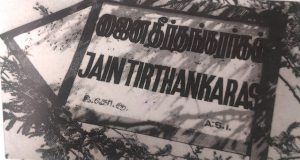Tamilnadu
Since Gingee, a minor town in Tamilnadu easily accessible by bus from Madras, Pondicherry and Bangalore, has got a new hotel, conveniently situated opposite the bus stand, it offers itself as an ideal station for users of this guide.
The two districts of North and South Arcot, with Gingee in the centre, constitute a vast expanse of fertile land, here and there dotted with abruptly rising mountains of moderate heights, that has acquired and retained a charm of its own, a charm further enhanced by the good-looking and very hospitable inhabitants.
There is no need to travel great distances to still another village with an old Jaina temple kept in active worship and usually located at the end of a so-called ‘Jain Street’.
When viewed from the exterior, these temples may look poor, but most of them contain precious images of Tirthankaras and attendant figures in both stone and metal, in some cases in such great number that there is hardly room to display them all. Here lies ample scope for students of Jaina art, since as yet very few of these objects have been documented.
Being taken care of by two Jaina families from Gingee, as it happens to us, means more than just being guided to places of worship, it also means meeting the people who do the worshipping. These worshippers are the descendants of Tamilnadu’s once predominant Jaina population. Not long after the nirvana of Mahavira, it is believed.
Jaina monks reached the land of the Tamils, learned their language and began to spread the message of non-violence. Being shown the dressed stone-beds of those early missionaries (ill. 86) leaves one in awe of what human calling nothing their own, are capable of accomplishing. In their case they succeeded to give an old culture a new direction.
From these early beginning to about the ninth/tenth century, great sages such
 Take a guide or look for this sign on the right-hand side of a dirt track, about two kilometres north of Gingee. Cross the track and follow the bridlepath westward. The hill of the twenty-four Tirthan- karas lies to the left of the path.
Take a guide or look for this sign on the right-hand side of a dirt track, about two kilometres north of Gingee. Cross the track and follow the bridlepath westward. The hill of the twenty-four Tirthan- karas lies to the left of the path.
- See map, page 66, and appendix.
as Acharya Kundakunda kept the teaching of the twenty-four Tirthankaras alive in the land of the Tamils. Wise kings saw to it that tolerance was observed between Hindus, Jainas and Buddhists.
It was a vigorous age:
temples were built, statues sculptured, metal icons fashioned and literary masterpieces composed. But then, in the aftermath of a religious Hindu resurgence, a period of persecution of Buddhists and Jainas by fanatical Hindu leaders and rulers took its course. These ugly events in which many Jainas were put to death, tapered off in the thirteenth century.
thanks to a few enlightened kings; however, because many Jainas had succumbed to the proselytising pressure and accepted conversion, the glory of the once lively Jaina culture in this part of India never returned. Still, not all was lost and at present there are signs of Jainism becoming once more a driving force in Tamilnadu. According to census figures, the Jaina population in Tamilnadu has increased from 41,097 in 1971 to 66,900 in 1991.
The village of Melsittamur, eleven kilometres east of Gingee (take a bus to Velam, then walk two kilometres), is the religious centre for the Jainas living in North and South Arcot.
Here the only Bhattaraka of Tamilnadu resides in a spacious building next to a walled temple of enormous size. There exist close links between the Bhattarakas of Melsittamur and Humcha in Karnataka, their common bond being the adoration of Padmavati Devi.
Because of lack of space only a limited number of Jaina places in Tamilnadu can be featured in this chapter, so there are great sights left to be looked for by the adventurous traveller.
A comprehensive survey of Jaina temples and holy sites in Tamilnadu needs still to be undertaken. Their number, according to a leaflet circu- lated in 1981 by the Digambara Jaina Youth Forum in Madras, may be in the order of 500 to 600′; the number of worthy objects of art should be several times this figure.
